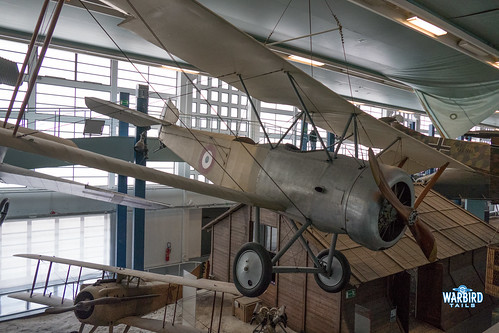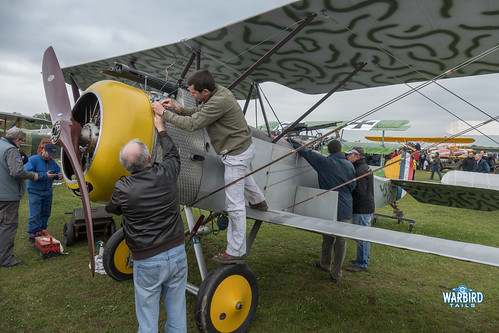Following the early success brought about by the Tabloid, Schneider and Baby designs utilised in 1914 and 15, it was time for Sopwith’s attentions to turn to a new design to meet the Royal Flying Corps needs. While those early designs had performed well they were still essentially a pre-war sports aircraft adapted to suit.

The Stutter replica at the RAF Manston History Museum, built for the “Flyboys” movie.
Initial Design:
In June 1915, Thomas Sopwith himself made a visit to the front lines, in order to discuss with airmen what was required to make a good fighting aircraft. From these talks he was able to write a series of notes on what would make a good successor to some of the inferior types currently doing the job.
This new design, led by Sopwith himself and helped by RJ. Ashfield and Herbert Smith was a new bi-plane, it featured and in line 2 seat configuration and was powered by a 110 horsepower Clerget. One feature which made the Strutter a first was the inclusion of the Vickers-Challenger interrupter gear, in addition to the rear seat gunner, a first for a British aircraft. The Strutter was also one of the first aircraft to feature air brakes on the trailing edge of the wings.

The Stutter replica at the RAF Manston History Museum, built for the “Flyboys” movie.
Having a machine gun which could fire through the propellor would mean that Britain would finally be able to combat the much feared Fokker Eindecker designs, which had been the first to include the interrupter gear pioneered by Anthony Fokker. This technological advance led to complete air superiority for the Germans. With the period that followed being dubbed the “Fokker Scourge” by English media. This period is noted to have begun in July of 1915. The Strutter would be Sopwith’s first reply.

First taking to the skies in December 1914, the new aircraft had a distinctive support structure for the wings. With the traditional full length wing struts supporting the outer part of the wings, a half sized strut was used for the inner wings. These half sized struts were positioned on a 45 degree angle, joining at the fuselage near the cockpit. This distinctive look brought about the nickname from pilots and ground crew of the “1 and a half strutter”, it was soon adopted as the types name.
Combat Service:
Following test flying the Strutter was delivered to the Royal Navy in February 1916 and the Royal Flying Corps later in the year. Soon enough the Strutter had become a hugely popular design, to such an extent that the production was soon outsourced to France and Russia.
No. 5 Wing of the Royal Naval Air Service were the first to have a complete flight of the new Sopwith and their initial missions were escorting bombers as well as carrying out raids themselves. The reason the RFC did not receive their orders until late was that production demand was so high some orders were sub-contracted to Proctor and Vickers, who did not get into their production at a high rate until August. As a result it was decided that some of the RNAS aircraft would be transferred to RFC, allowing 70 Squadron to be kitted out with the Strutter in time for the Battle of the Somme.

The Stutter replica at the RAF Manston History Museum, built for the “Flyboys” movie.
In July 1916 the Strutter became the first Sopwith to be involved in a dogfight, when a pair from No. 5 Wing spotted a formation of enemy aircraft near Ostend. They dived down to attack but shortly after starting the forward firing gun in one aircraft jammed, as did the rear facing gun of the other, providing a less than fair fight!
The Strutter performed well during this time, the Fokkers dominance had been overcome and the Sopwith’s increased performance led to long range patrols over German territory. However like many designs during the First World War, its time on top was short lived, by October 1915 the Albatros had appeared on the scene and completely outclassed the Strutters, even the fitting of an uprated 130hp engine did little to help the cause. They were simply too slow and the stable design made them unsuitable for dogfighting.
Efforts were made to “make do” with the Strutter though. One favoured method was to position underneath an enemy formation and make the enemy aircraft attack, then it would be up to the Strutter observers to shoot down the enemy fighters.
The Strutter was kept on as a reconnaissance aircraft, but suffered greatly during the “Bloody April” of 1917, with 43 Squadron suffering 35 casualties. Front line versions of the type were phased out during 1917 in favour of the Pup and Camel designs. After this withdrawal the aircraft remained in active service as part of Britain’s home defence Squadrons.

The Stutter replica at the RAF Manston History Museum, built for the “Flyboys” movie.
Though a large amount of the Strutters life was carried out in the Two Seater configuration there were a number of single seat variant, the first such design was the bomber version. This machine could carry four 65lb bombs internally, instead of the rear cockpit, small bomb-bay doors were fitted which were opened whenever the release mechanism was activated.
Top Ace:
Though the Strutter was soon outclassed as a gun platform, that didn’t stop it gathering a number of aces, with the most impressive among them being Geoffrey Cock, who claimed 13 kills in the type:
Originally joining the 28th London Regiment in December 1915, Geoffrey Cock was seconded to the Royal Flying Corps in June 1916. Following training with 25 reserve squadron and gaining his wings, he moved to France with 45 squadron on the 14th October. He made quite a large impression during his time with the flight, of which all was on Strutters. In May 1917 he was promoted to the commander post of B flight.
He had to wait a little while for success to come to him though, with his first victory not being claimed until the 6th April 1916, though he did manage two at once! Two Albatros D.IIIs, one shot down and one driven out of control, at 10:30 near Lille, impressive given the Sopwith’s limitations.
What followed was something of a purple patch, with a further 11 victories being added to his tally by the 22nd July, all but one of these were Albatros fighters. Overall, 3 of the victories were confirmed as destroyed, with 9 of them being listed as driven out of control. The final victory in his list was a shared kill. These 13 victories made Cock easily the most successful Strutter ace, it is likely he would have added greatly to this list had he not been shot down and captured by German forces on the 22nd July.
After failing to escape prison, he was eventually brought back to Britain in December 1918 and rejoined the RFC, by then of course known as the RAF. By 1935 he was commanding 9 Squadron at Boscombe down, and retired in 1943 with the rank of Group Captain, quite the career.
Survivors:
1,439 Strutters were built in the UK, but this production was dwarfed by the French efforts which constructed 4,500 of the Sopwith machines. Despite this, and sadly, only four original aircraft remain:
Two can be found in France, one example, No.556 can be found at the Paris Air and Space museum at Le Bourget.
The other, No.2897 can be found with the Memorial flight, at La Ferte Alais, which after a long restoration flew again in 2012 and remains the only original Strutter in airworthy condition.
Another example, S85 can be found in the impressive aviation collection at the Brussels Army museum.
One last original, a machine from Argentina is apparently under restoration at the impressive Vintage Aviator Collection based in New Zealand, hopefully soon to join the French example in the skies.

The Stutter replica at the RAF Manston History Museum, built for the “Flyboys” movie.
As is the case with most First World War designs, there are a wide range of replicas of the Strutter around the world, in the UK there are replicas on display at Manston and the RAF Museum at Cosford as well as another under construction at East Fortune.

The Stutter replica at the RAF museum Cosford.

The Stutter replica at the RAF Museum Cosford.
There are two flying replicas over the Atlantic as well.
An underrepresented type in terms of survivors then, but certainly due a minor resurgence in the next few years with the projects in New Zealand and East Fortune to look forward to.
The next look into the Sopwith company’s first world war will look at another type that came to the lines around the same time as the Strutter, the Sopwith Pup.



3 thoughts on “Sopwith’s First World War Part 2: The Sopwith 1 1/2 Strutter”